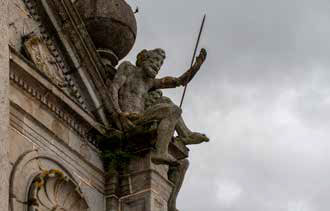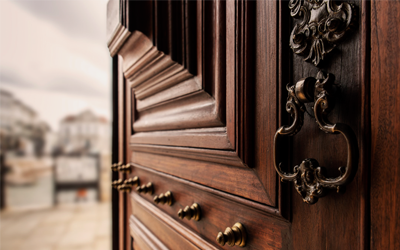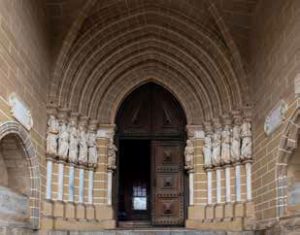Eastern Way
Viana do Alentejo < > Évora
Stage 8
There is not enough space here to the describe the many obligatory visits that the fascinating Évora offers us: the Cathedral, the countless churches, the Roman temple, the University, the genuine and ancient alleys, the convents and megalithic monuments in the vicinity, the Capela dos Ossos (Bones Chapel) in the Church of São. Francisco, where the message on the door is a reminder of the timeless human frailty: “We bones who are here, waiting for yours”… Without forgetting the Church of São Tiago, which for more than 700 years has exhibited on the top of its pediment the apostle Santiago on horseback, fighting the Moors. The magnificent interior is covered with azulejomurals and paintings from more recent times, enhanced with a beautiful golden carved altarpiece in the main chapel.

Church of Graça

Church of Santo Antão (gothic altar pediment)
One of the most monumental churches in Évora was finished in the time of cardinal D. Henrique.The scenic and austere Mannerist church-salon was started in 1557, according to the architect Miguel de Arruda’s project. The temple was completed in 1563, but an earthquake, five years later, required some restoration works, with the whole finished in 1570, the year in which the cardinal D. Henrique also promoted the construction of the fountain of Praça do Giraldo square. Most of the contents date back to the 17th and 18th centuries, with the exception of the alabaster altar pediment, where the Apostolate (and Santiago among the apostles) was depicted, one of the few works of Evora sculpture of the 15th century that are still preserved.

Church of Santo Antão (gothic altar pediment)
One of the most monumental churches in Évora was finished in the time of cardinal D. Henrique.The scenic and austere Mannerist church-salon was started in 1557, according to the architect Miguel de Arruda’s project. The temple was completed in 1563, but an earthquake, five years later, required some restoration works, with the whole finished in 1570, the year in which the cardinal D. Henrique also promoted the construction of the fountain of Praça do Giraldo square. Most of the contents date back to the 17th and 18th centuries, with the exception of the alabaster altar pediment, where the Apostolate (and Santiago among the apostles) was depicted, one of the few works of Evora sculpture of the 15th century that are still preserved.
and also…
São João Fair
The Saint John’s Fair has existed under this name since 1569, but other fairs were already held at the Rossio de São Brás in Évora: Feira de Santiago (1275), Feira Franqueada (since 1286), Feira dos Pucarinhos ou das Candeias (1525), Feira dos Estudantes (1569), Feira dos Ramos (1839), Feira Nova de São Cipriano (since 1900). The first Feira de São João was held in the largest open space in Évora, the Rossio de São Brás, on June 24, 1569. Years later, in 1574, D. Sebastião’s license was created, which regulated that the fair would always take place in the space where it still takes place today. At that time, as still a little bit today, the Fair was composed of merchants’ tents and crafts, such as gold and silver goldsmiths, silk merchants, candle-makers, boilermakers, leather tanners, colored cloth merchants, crockery potters, spinners, shoemakers, weavers, etc. With the passing of time, although the popular character has not changed, the Feira de São João de Évora has undergone some changes. During the Estado Novo (New State), after 1940, it served to reinforce the Portuguese culture, with the costume parades and other manifestations that would transmit the idea of a united, even imperial, homeland. After the 25th of April 1974, the fair was modernized, and the economic activities started to be highlighted. The importance of the São João Fair for Évora has been such that, in the middle of the 20th century, the municipal holiday was fixed on June 29th (Saint Peter’s Day).
Tips
Always carry water, supplies, sunscreen, a hat, waterproof, comfortable shoes, and a map.
Support
CTT Post Office
Bank/Cash Dispenser
Évora Tourism Office +351 266 777 071
Táxis
Public Entities
Évora City Council
+351 266 777 000
Évora Parish Councils (São Mamede, Sé, São Pedro and Santo Antão)
+351 266 707 792
Health
Espírito Santo de Évora Hospital
+351 266 740 100+351 266 740 100
Pharmacy
Points of Interest
São Bento de Castris Monastery
Remédios Monastery
Évora Cathedral
Nossa Senhora da Cabeça Chapel
São Brás Church
Santo Antão Church
São Francisco Church and Ossos Chapel
São Mamede Church
São Tiago Church
Misericórdia Church
Nossa Senhora das Mercês Church
Água da Prata Aqueduct
D. Isabel Roman Arch
Almendres Cromlech
Cordovil House
Colored Houses
Praça do Giraldo Fountain
Domus
Nossa Senhora do Ó Hermitage
Playroom and Toy Museum
Scale House
Évora Roman Temple
USEFUL CONTACTS
Emergency: 112
Forest Fires: 117
GNR − National Republican Guard: +351 266 748 400
PSP − Public Security Police: +351 266 760 450
Évora Civil Protection: +351 800 206 405
CODE OF CONDUCT
Do not leave the marked and signaled route. Do not approach cliffs. Pay attention to the markings. Do not dispose of organic or inorganic waste during the trail, take a bag for this purpose. If you see garbage, collect it, help us to keep the Paths clean. Beware of livestock, don’t bother the animals. Leave Nature intact. Do not collect plants, animals or rocks. Avoid making noise. Respect private property, close gates and barriers. Don’t light fires and be careful with cigarettes. Do not vandalize the Paths signage.
